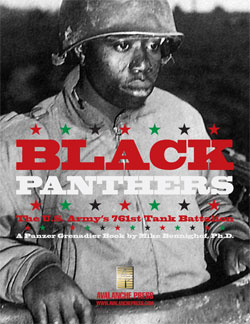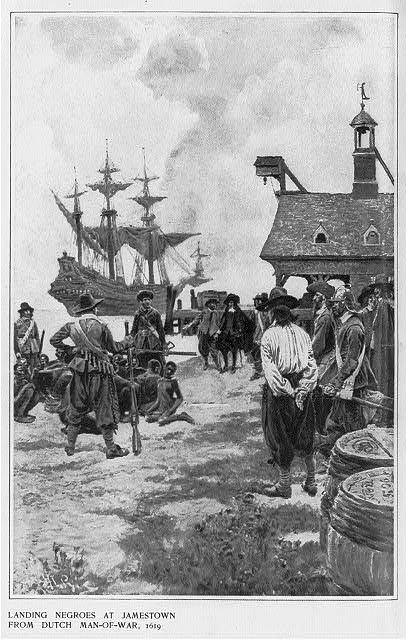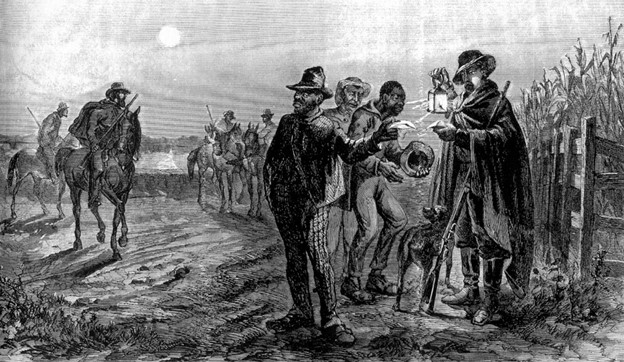| Race in America:
Founded on Slavery
By Mike Bennighof, Ph.D.
June 2021
 Note: “Critical Race Theory,” at this writing a political buzzword that will be forgotten as soon as the screeching idiots become enraged by some new phrase which they also don’t understand, is simply the study of racist aspects of institutions that linger in their structure for generations. As such, it’s pretty vital to the story of how the U.S. Army came to have segregated military units during the Second World War. So let’s have a look, if you dare. Note: “Critical Race Theory,” at this writing a political buzzword that will be forgotten as soon as the screeching idiots become enraged by some new phrase which they also don’t understand, is simply the study of racist aspects of institutions that linger in their structure for generations. As such, it’s pretty vital to the story of how the U.S. Army came to have segregated military units during the Second World War. So let’s have a look, if you dare.
All lives matter.
It’s an innocuous phrase, surely unobjectionable, one that everyone can support.
It’s also useful for those who’d avoid an uncomfortable truth: in the United States, all lives have not been bought and sold as though they were cattle.
Slavery is as old as European settlement in what is now the United States. The first attempt at permanent settlement came in 1526, when Spanish entrepreneur Lucas Vázquez de Ayllón brought between 600 and 700 settlers to what is now known as Sapello Island along the central coast of Georgia. The group included a number of enslaved Africans, probably not many; the expedition’s chronicler, Gonzalo Fernández de Oviedo, does not specify an exact count.
Things went badly for the colony; hunger, cold, disease and indifferent locals all combined to make the settlers miserable and kill a fair number of them. Some of the settlers mutinied and attacked a nearby Indian village, turning the Indians’ indifference to outright hostility. At some point the slaves rebelled against the mutineers and burned down their leader’s home. With the mutiny suppressed, the colonists returned to Hispaniola, not without further misery including cannibalism. Perhaps one out of four made it back; there appears to be no record of how many, if any, of the slaves survived.
The story of African enslavement resumes four decades later, when Spanish settlement on the mainland finally took permanent hold in St. Augustine, Florida. The contract that Pedro Menendez, the city’s founder, signed with King Philip II of Spain required that he import 500 slaves to labor on sugar plantations. While Menendez never met that number, enslaved Africans helped build the city from the first days.
 At Jamestown, Virginia in 1619, enslaved Africans first arrived in the English colonies that would become the United States. The English privateer White Lion (that’s her over there on the right), operating under a Dutch letter of marque, arrived bearing “20 and odd Negroes” they had taken as plunder from a Portuguese slave ship. They were sold to local planters, who promptly put them to work. Legally these were indentured servants just like the white English workers also toiling on the plantations; their exact status is unclear, as in the years after White Lion’s arrival records show both free and enslaved Black people in the Virginia colony. At Jamestown, Virginia in 1619, enslaved Africans first arrived in the English colonies that would become the United States. The English privateer White Lion (that’s her over there on the right), operating under a Dutch letter of marque, arrived bearing “20 and odd Negroes” they had taken as plunder from a Portuguese slave ship. They were sold to local planters, who promptly put them to work. Legally these were indentured servants just like the white English workers also toiling on the plantations; their exact status is unclear, as in the years after White Lion’s arrival records show both free and enslaved Black people in the Virginia colony.
A generation later, a Black indentured servant named John Punch ran from his master along with two white servants. Hauled before a Virginia colonial court, the two white men had their indentures extended, but Punch was reduced to life-long chattel slavery. A generation after Punch, another Virginia court issued a ruling stating clearly that a person’s slave or free status descended through his or her mother. Race-based slavery had entered the American legal system.
By 1776, people of African descent made up about 20 percent of the estimated 2.5 million residents of the 13 colonies that rebelled against British rule. Of those roughly 500,000 people, 92 percent were enslaved. While the slave population clustered in the South – 60 percent of South Carolina’s population was enslaved, and 40 percent of Virginia’s – slaves existed in at least tiny numbers in all 13 colonies. In the North, most were concentrated in the growing urban centers.
African-Americans fought on both sides during the Revolution, with about 20,000 men accepting British inducements to shake off their chains and fight for King and Country, and about 9,000 siding with the Patriots. That represented about 4 percent of the total number of men who fought in the Continental Army or the various colonial militias, but the African Americans served on average more than eight times as long as their white counterparts. About 25 percent of the Continental Army’s manpower over the eight-year conflict, therefore, was Black. Black soldiers for the most part served alongside white soldiers in integrated units – only the 1st Rhode Island Regiment segregated its Black soldiers into separate companies.
After the war, the British transported some of their Black supporters to Canada, some of whom then moved on to Sierra Leone in West Africa. Others were enslaved again, despite the promise of freedom, and sent to work plantations in the West Indies.
Black Patriots found no place in the post-war American military establishment. In 1792, Congress formally forbade Black participation in the armed forces. A few states allowed free Blacks to carry arms in their state militias. Most Northern states abolished slavery either during or immediately after the Revolution, and even in the South the number of free Blacks increased.
The new Constitution did not expressly name slavery as an institution, adopting tortured linguistic work-arounds to avoid the word. The notorious Three-Fifth Compromise did not, popular notions aside, codify a Black person as 60 percent of a white person; it was rather an elaborate racial gerrymander that allowed slave states to claim 60 percent of their slave population (the “other persons”) toward their apportionment of Congressional seats and, by extension, votes in the Electoral College. The slaves had no vote and no voice, not even three-fifths of one.
That arrangement gave the slave-holding states – all of those from Maryland and Delaware southward – disproportionate power to elect a president. Ten of the first twelve American presidents owned slaves, ranging from the hundreds held by George Washington and Thomas Jefferson down to one owned by Martin van Buren, who did not bother to try re-enslaving him when he ran away.

A slave patrol checks for proper papers.
While the early presidency did not hold all of the powers, both formal and informal, that the office has accumulated since, it still controlled nominations to the Supreme Court, which greatly favored the slave-owning cause. Early on, the so-called Slave Power recognized the vital position of the Court in defending an unpopular and, in the views of a growing number of Northern citizens – and even some Southern slaveholders - outright evil institution. That power flexed as early as 1789, when the Northwest Ordnance governing the territories of the Upper Midwest included a “fugitive slave clause” requiring local authorities to return escaped slaves to their owners – in effect making those authorities instruments of the institution of slavery.
As a concession, the Northern states extracted an end to the importation of slaves, but with a window of 20 years during which the trade could continue. During that window, imports surged. North America had never been a major destination for slave traders; perhaps four percent of the total number of Africans brought to the New World came to the British colonies that became the United States.
Slavery had seemed on its way out, probably accounting for some of the Northern states’ reluctance to go to the mat over the issue during the Constitutional Convention. But in 1794, Eli Whitney patented his design for the cotton gin. Short-staple cotton became immensely profitable. Plantations switched to the new cash crop, and new lands were seized from their Indian inhabitants and given over to cotton fields.
A new, internal slave trade developed, with tens of thousands of slaves sold to the new cotton lands. Old, played-out plantations in Virginia and Maryland now made their profit by breeding and selling slaves who were marched south in large convoys organized by entrepreneurs, or sent by ship. That trade benefitted slaveowners and the banks that underwrote them, as well as the insurance companies that wrote policies on slaves, and goes far to explain the urge of Southern politicians to extend slavery into new territories in the West. Given the fall in value of the old plantations, the internal trade at best kept the Virginia planters afloat and could not replace the value of the cash crops they had once grown. But it kept Virginia in the ranks of the slave states, when the institution might otherwise have withered and died.

An Alexandria, Virginia slave pen, photographed by Matthew Brady during the Civil War. American soldiers took a particular satisfaction in using slave pens to hold captured enemy combatants.
American colonists agitated to remove Texas from Mexican rule to become a slave state, and the United States fought a war to bring that vision to reality. It also brought the United States most of northern Mexico, ripe territory for the expansion of slavery.
While slavery’s advocates – underwritten by the banks and insurance companies that profited from its existence – pressed to extend the institution into all new states, a continued set of compromises limited its expansion. Even so, slavery as an institution faced no meaningful challenge; the Supreme Court’s Dred Scott decision of 1858, forcing Illinois authorities to hand over an escaped slave, in effect made Northern law enforcement an extension of the slave patrols in the South.
The pro-slavery faction held a very strong hand, and then they overplayed it. The four million slaves represented several billion dollars in cash value in 1860; in 21st Century terms that would run well into the trillions. No compromise could unwind slavery without crashing the American economy, with banks and insurance companies and railroads and shipping companies all directly involved and mills and factories indirectly dependent on slave output. Only war could provide the sort of social upheaval that might destroy slavery. And that’s exactly what the pro-slavery faction set out to provoke.
The full series is here:
• Race in America: Founded on Slavery
• Race in America: Civil War
• Race in America: Jim Crow
• Race in America: The Black Doughboys, Part One
• Race in America: The Black Doughboys, Part Two
• Race in America: Red Summer
• Race in America: Tulsa
• Race in America: Klan Scam
• Race in America: Strange Fruit
You can order Black Panthers right here.
You will need Panzer Grenadier: Elsenborn Ridge to play Black Panthers.
You can order them together for one low price right here.
Sign up for our newsletter right here. Your info will never be sold or transferred; we'll just use it to update you on new games and new offers.
Mike Bennighof is president of Avalanche Press and holds a doctorate in history from Emory University. A Fulbright Scholar and NASA Journalist in Space finalist, he has published an unknowable number of books, games and articles on historical subjects.
He lives in Birmingham, Alabama with his wife, three children and his dog, Leopold.
Want to keep Daily Content free of third-party ads? You can send us some love (and cash) through this link right here. |
